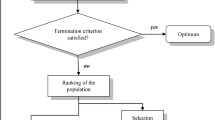Abstract
The anisotropic coefficients of Hill’s yield criterion are determined through a novel genetic algorithms-based multi-objective optimization approach. The classical method of determining anisotropic coefficients is sensitive to the effective plastic strain. In the present procedure, that limitation is overcome using a genetically evolved meta-model of the entire stress strain curve, obtained from uniaxial tension tests conducted in the rolling direction and transverse directions, and biaxial tension. Then, an effective strain that causes the least error in terms of two theoretically derived objective functions is chosen. The anisotropic constants evolved through genetic algorithms correlate very well with the classical results. This approach is expected to be successful for more complex constitutive equations as well.





Similar content being viewed by others
References
Hill, R., Proc. R. Soc. Lond. A, 1948. 193(1033): p. 281-97.
Zang, S.L., S. Thuillier, A. Le Port, and P.Y. Manach. Int. J. Mech. Sci, 2011. 53(5): p. 338-47.
Banabic, D., H. Aretz, D.S. Comsa, and L. Paraianu, Int. J. Plast., 2005. 21(3): p. 493-512.
Jackiewicz, J. Mater. Manuf. Process., 2009. 24(3): p. 375-83.
Chaparro, B.M., S. Thuillier, L.F. Menezes, P.Y. Manach, and J.V. Fernandes. Comput. Mater. Sci, 2008. 44(2): p. 339-46.
Coello, C.A.C., G.B. Lamont, and D.A. Van Veldhuisen, Evolutionary Algorithms for Solving Multi-objective Problems. 2 ed. 2007, Springer, New York.
Datta, S. and P.P. Chattopadhyay. Int. Mater. Rev, 2013. 58(8): p. 475-504.
Chakraborti, N., Int. Mater. Rev, 2004. 49(3–1): p. 246-60.
N. Chakraborti: in Informatics for Materials Science and Engineering, Butterworth-Heinemann, Oxford, 2013, pp. 71–95.
Paszkowicz, W., Mater. Manuf. Process., 2013. 28(7): p. 708-25.
Banabic, D., Sheet Metal Forming Processes. 2010: Springer, Berlin.
Deb, K., Multi-Objective Optimization Using Evolutionary Algorithms. 2001: Wiley, Chichester
Mondal, D.N., K. Sarangi, F. Pettersson, P.K. Sen, H. Saxén, and N. Chakraborti. Hydrometallurgy, 2011. 107(3–4): p. 112-23.
Pettersson, F., N. Chakraborti, and H. Saxén, Appl. Soft Comput., 2007. 7(1): p. 387-97.
Miettinen, K., Nonlinear Multiobjective Optimization. 1999: Kluwer Academic Publishers, Boston.
Li, X., in Evolutionary Multi-Criterion Optimization, C. Fonseca, et al., Editors. 2003, Springer Berlin Heidelberg. p. 207-21.
Lee, J.Y., L. Xu, F. Barlat, R.H. Wagoner, and M.G. Lee, Exp. Mech, 2013. 53(9): p. 1681-92.
Pettersson, F., A. Biswas, P.K. Sen, H. Saxén, and N. Chakraborti, Mater. Manuf. Process, 2009. 24(3): p. 320-30.
Ulutan, D., T. Özel, Mater. Manuf. Process., 2013. 28(7): p. 835-41.
Barlat, F., J.C. Brem, J.W. Yoon, K. Chung, R.E. Dick, D.J. Lege, F. Pourboghrat, S.H. Choi, and E. Chu, Int. J. Plast., 2003. 19(9): p. 1297-1319.
Barlat, F., J.W. Yoon, and O. Cazacu, Int. J. Plast., 2007. 23(5): p. 876-96.
This work was supported by the National Research Foundation of Korea (NRF) Grant funded by the Korea Government (MSIP) (No. 2012R1A5A1048294) and the Grant from the Industrial Source Technology Development Program (#10040078) of MKE.
Author information
Authors and Affiliations
Corresponding author
Additional information
Manuscript submitted January 13, 2014.
Rights and permissions
About this article
Cite this article
Hariharan, K., Chakraborti, N., Barlat, F. et al. A Novel Multi-objective Genetic Algorithms-Based Calculation of Hill’s Coefficients. Metall Mater Trans A 45, 2704–2707 (2014). https://doi.org/10.1007/s11661-014-2274-5
Published:
Issue Date:
DOI: https://doi.org/10.1007/s11661-014-2274-5




